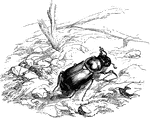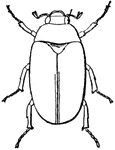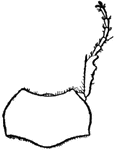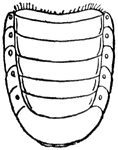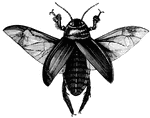
Beetle
Beetles have two pair of wings with the first pair being hard and horny, (Wood, 1896). (Wood, 1896).
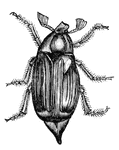
Beetle
Beetles are members of the Coleopterans, the largest order of insects. They are distinguished by a hard…

Beetle
Beetles are members of the Coleopterans, the largest order of insects. They are distinguished by a hard…

Bacon Beetle (Dermestes Lardarius)
"They eat bacon, skins, and also attack each other. The perfect insect does no damage. Insects in this…

Blackspotted Pliers Support Beetle
"The Leptura Mordax, or Rhagium Mordax of Europe, three-fourths of an inch long,…
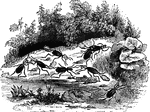
Bombadier Beetle
"The bombadier beetle has a large oval abdomen, which secretes a caustic fluid. They live in societies,…
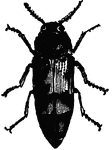
Buprestis (Cyria) Imperialis
"It is very rare in northern climates. It may be found on birch trees. In the hottest parts of the world…
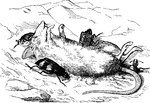
Burying Beetles
"The Burying Beetles are prompted by their insect to bury any small animals or pieces of carrion as…

Pupa of Calosoma Auropunctata
"A very beautiful specimen of this tribe may be found in June on oak-tees."

Campylocnemis Schroeteri
"An Australian insect, of a bright black, which attains to more than an inch and three quarters in length,…
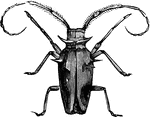
Capricorn Beetle
"The insects of this tribe, called Capricorn Beetles and distributed throughout most parts…

Carabus Canaliculatus
"Abounds in trees and gardens. When it is touched it disgorges a black and acrid saliva, and ejects…

Cetonia Argentea
"These insects often feed upon matter in a state of putrefaction. They are nature's undertakers. A great…

Churchyard Beetle
"These insects are generally found in dark and dirty places about houses, in cellars, and similar situations."…

Click Beetle
"The Elater striatus of Caenne, is an inch long, of a black color, and striped upon the back."…
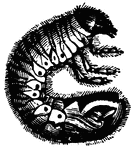
Larva of the Cockchafer (Melolontha Vulgaris)
"In from four to six weeks after being laid, the little larvae are hatched, and immediately attack the…

Larva of the Cockchafer (Melolontha Vulgaris)
"In from four to six weeks after being laid, the little larvae are hatched, and immediately attack the…

Pupa of the Cockchafer (Melolontha Vulgaris)
"At the end of the third year it changes into a pupa, after having surrounded itself with a cocoon consolidated…

Pupa of the Cockchafer (Melolontha Vulgaris)
"At the end of the third year it changes into a pupa, after having surrounded itself with a cocoon consolidated…
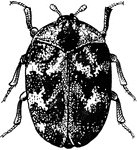
Adult Common Carpet Beetle
An adult common carpet beetle, a small grayish or black beetle belonging to the order Coleoptera.

Common Carpet Beetle Pupa
Pupa of the common carpet beetle, a small grayish or black beetle belonging to the order Coleoptera.

Ctenostoma Rugosa
"According to a traveler, the women of Egypt eat these cooked with butter to make them fat. They are…
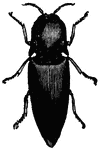
Cucuyo (Pyrophorus Noctilucus)
"An insect very common in Havana, Brazil, Guiana and Mexico. It may be seen at night in great numbers…

Deathwatch Beetles
"Other species, which also bore into timber in their larva state, are well known by the name of Death-watch…

Diamond Beetle
"Even among the small species several of great beauty are to be met with, and few insects can boast…
!["They introduce themselves under the skin of the carcasses of animals, and devour their flesh to the bone. [This] species climbs trees and attacks caterpillars."](https://etc.usf.edu/clipart/53400/53403/53403_silpha_quadr_mth.gif)
Dung Beetle (Silpha Quadrapunctata)
"They introduce themselves under the skin of the carcasses of animals, and devour their flesh to the…

Dynastes Hercules
"The Ateuchi are large, flat insects, with a broudtoothed clypeus. To this genus belongs the…

Dyticus Marginalis (Female)
"The most common species of the Dytici, or Water Beetles. They sometimes attack the Hydrophilus…

Dyticus Marginalis (Male)
"The most common species of the Dytici, or Water Beetles. They sometimes attack the Hydrophilus…

Larva of Galerita Lecontei
"The innumerable tribe of Harpalidae (or Harpalinae) contains carnivorous beetles of very small size.…

Female Lampyris Noctiluca
"It has the power of making its natural torch shine or disappear at will. The luminous properties with…
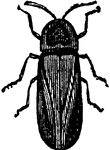
Male Lampyris Noctiluca
"It has the power of making its natural torch shine or disappear at will. The luminous properties with…

Golden Ground Beetle (Carabus Auratus)
"Abounds in trees and gardens. When it is touched it disgorges a black and acrid saliva, and ejects…

Goliathus Cacicus (Male)
"This represents the Goliaths. These insects often feed upon matter in a state of putrefaction. They…

Goliathus Derbyana
"This represents the Goliaths. These insects often feed upon matter in a state of putrefaction. They…

Goliathus Polyphemus
"This represents the Goliaths. These insects often feed upon matter in a state of putrefaction. They…

Great Diving Beetle Adult and Larvae
"The Dyticus marginalis, a European species very common in ponds, attains a length of more…

Great Diving Beetle Female
"The Dyticus marginalis, a European species very common in ponds, attains a length of more…

Gyrinus Distinctus
"A distinct species, which exists in a little lake of mineral waters in France, where visitors amuse…
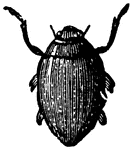
Gyrinus Natator
"They swim rapidly, describing incessantly capricious circles. These movements have gained for them…

Larva of Gyrinus Natator
"They swim rapidly, describing incessantly capricious circles. These movements have gained for them…
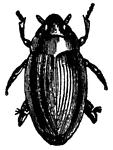
Gyrinus Striatus
"The Gyrinus Striatus is found in the waters of Southern Europe. These insects are all small,…

Harpalus Aeneus
"The innumerable tribe of Harpalidae (or Harpalinae) contains carnivorous beetles of very small size.…
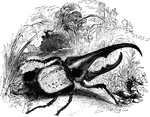
Hercules Beetle
"The hercules beetle is a native of Brazil, sometimes attaining a length of five inches." — Goodrich,…
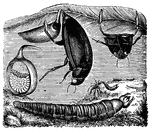
Hydrophilus Piceus
"It is common in fresh waters. It must not be seized without taking precautions, as its breast is provided…

Bristles at the Extremity of the Abdomen of the Hydrophilus Piceus
"The female is sometimes seen clinging to aquatic plants head downward, forming her cocoon, terminated…
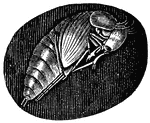
Pupa of the Hydrophilus Piceus
"At the end of two months the larva comes out of the water and burrows into the ground to undergo its…
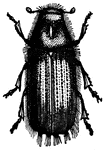
Hylesinus Piniperda
"All vegetables, the vine, fruit trees, the ash, pine, etc., are eaten by some weevil or other."

Inca Clathrata
"They are met with in South America. The males have an extraordinary head. They fly during the day around…

